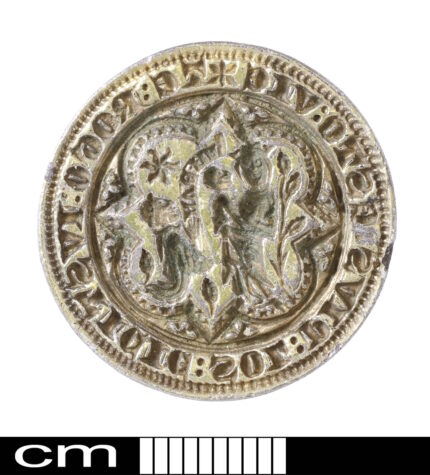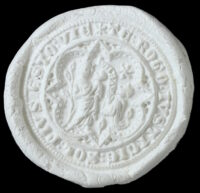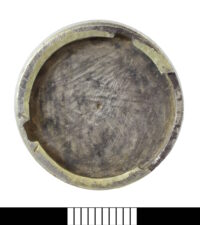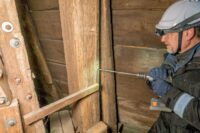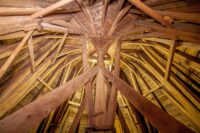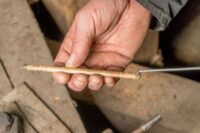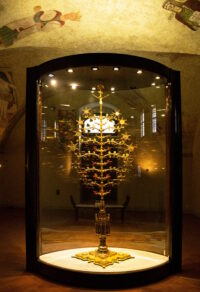 Pieces of the Golden Tree of Lucignano, a monumental reliquary that is a masterpiece of medieval goldsmithing and widely considered one of the greatest masterpieces of Italian goldsmithing of any era, have been rediscovered 109 years after they were stolen. The pieces were found in a cave in the Arezzo area of central Tuscany after a tip from an elderly man. The region of Tuscany has now funded a full restoration of the Golden Tree to reintegrate the recovered elements into the original.
Pieces of the Golden Tree of Lucignano, a monumental reliquary that is a masterpiece of medieval goldsmithing and widely considered one of the greatest masterpieces of Italian goldsmithing of any era, have been rediscovered 109 years after they were stolen. The pieces were found in a cave in the Arezzo area of central Tuscany after a tip from an elderly man. The region of Tuscany has now funded a full restoration of the Golden Tree to reintegrate the recovered elements into the original.
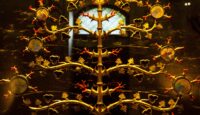 The Golden Tree is 8’10” high and more than three feet wide at its widest point. It was crafted of gilded copper, silver and enamel, and its branches decorated with corals, rock crystals and miniature illuminations on parchment. It was inspired by the Lignum Vitae (“wood of life”), a treatise written by Saint Bonaventure in the 1260s to aid Franciscans in devoting themselves to Christ by contemplating his life, passion and glorification. The structure of the tree served as a mnemonic device for monks to pursue the works of Christ in their daily meditation. Like Christ “nailed to a tree,” the Tree of Life ultimately bore the fruit of salvation. The lignum vitae concept took root (pun intended) in Franciscan communities and among lay readers, and it became a popular motif in medieval art.
The Golden Tree is 8’10” high and more than three feet wide at its widest point. It was crafted of gilded copper, silver and enamel, and its branches decorated with corals, rock crystals and miniature illuminations on parchment. It was inspired by the Lignum Vitae (“wood of life”), a treatise written by Saint Bonaventure in the 1260s to aid Franciscans in devoting themselves to Christ by contemplating his life, passion and glorification. The structure of the tree served as a mnemonic device for monks to pursue the works of Christ in their daily meditation. Like Christ “nailed to a tree,” the Tree of Life ultimately bore the fruit of salvation. The lignum vitae concept took root (pun intended) in Franciscan communities and among lay readers, and it became a popular motif in medieval art.
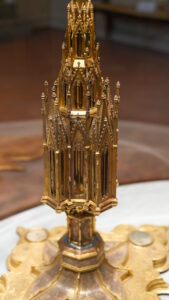 It was created for the church of Saint Francis in Lucignano in two distinct phases, first in 1350 by an unknown goldsmith which recent studies suggest was from Arezzo, then expanded and completed in 1471 by the pre-eminent goldsmith of 15th century Siena, Gabriello D’Antonio, famed as the creator of the gilded silver reliquary containing the right arm of John the Baptist.
It was created for the church of Saint Francis in Lucignano in two distinct phases, first in 1350 by an unknown goldsmith which recent studies suggest was from Arezzo, then expanded and completed in 1471 by the pre-eminent goldsmith of 15th century Siena, Gabriello D’Antonio, famed as the creator of the gilded silver reliquary containing the right arm of John the Baptist.
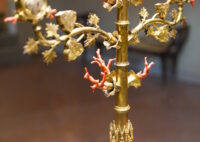 Medieval aesthetics privileged symbolic expressions of the divine. Precious materials — gold, silver, gemstones — were seen as expressions of God’s hand in creation. Their beauty mirrored the supreme beauty of God; the way they reflected light mirrored God’s radiance; they were closer to the divine, pure and incorruptible, unlike humble materials. Vivid colors and the shine of metal were considered lit by the incorporeal light of God. That’s why the gold-painted decorations in Bibles and liturgical books are called illuminations.
Medieval aesthetics privileged symbolic expressions of the divine. Precious materials — gold, silver, gemstones — were seen as expressions of God’s hand in creation. Their beauty mirrored the supreme beauty of God; the way they reflected light mirrored God’s radiance; they were closer to the divine, pure and incorruptible, unlike humble materials. Vivid colors and the shine of metal were considered lit by the incorporeal light of God. That’s why the gold-painted decorations in Bibles and liturgical books are called illuminations.
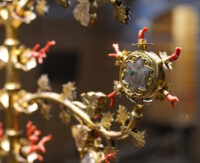 Ecclesiastic tradition held that objects of religious veneration like reliquaries and the Communion chalice and plate should be made of precious metals as metaphors for the divine. From the Carmina Ecclesiastica by the 7th century English abbot Aldhelm of Malmesbury:
Ecclesiastic tradition held that objects of religious veneration like reliquaries and the Communion chalice and plate should be made of precious metals as metaphors for the divine. From the Carmina Ecclesiastica by the 7th century English abbot Aldhelm of Malmesbury:
The gold chalice covered with gems glitters, just as heaven set with burning stars glows, and the broad paten fashioned from silver matches: those which carry the divine remedies of our life.
(Song 3, Lines 72-5)
The Golden Tree took the metaphors of divinity in the precious materials even further. The entire tree was a metaphor for Christ. Its roots represented his birth, the trunk his Passion and the branches his resurrection. Its tripartite design was also symbolic of the Trinity. At the top of the tree is a depiction of Christ crucified on a branching tree that is a small version of the whole reliquary. Above the cross is a figure of a pelican in piety, also symbolic of Christ’s sacrifice.
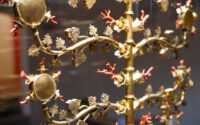 It was Lucignano’s greatest treasure, and for centuries residents took their vows of marriage in front of it. In 1914, the Golden Tree was stolen and broken into pieces by the thieves for ease of transport and, presumably, resale, since the huge and iconic reliquary was obviously highly recognizable when intact. The pieces were cached in various hiding spots in the country around Sarteano, near Siena. A number of them were found and recovered between 1927 and 1929, but several of the most important elements — the crucifix, the pelican, a whole branch, four circular medallions, five silver plaques, three miniatures, several sprigs of coral — were not among them.
It was Lucignano’s greatest treasure, and for centuries residents took their vows of marriage in front of it. In 1914, the Golden Tree was stolen and broken into pieces by the thieves for ease of transport and, presumably, resale, since the huge and iconic reliquary was obviously highly recognizable when intact. The pieces were cached in various hiding spots in the country around Sarteano, near Siena. A number of them were found and recovered between 1927 and 1929, but several of the most important elements — the crucifix, the pelican, a whole branch, four circular medallions, five silver plaques, three miniatures, several sprigs of coral — were not among them.
The recovered elements were reintegrated into the Golden Tree. The Royal Superintendence of Florence entrusted the complex restoration to the Opificio delle Pietre Dure. More than 100 fragments had to be reattached, and replicas of the parts that were still missing were made based on old photographs taken in the 19th century. The illuminated parchment miniatures were unreproducible and were replaced with empty parchment rounds. The restoration was completed in 1933 and the reconstituted Golden Tree has been on display ever since.
After they were tipped off to the possible location of pieces of the Golden Tree earlier this year, the Carabinieri Art Squad recovered:
- Five plaques of gilded copper and silver, engraved and enameled, that were originally mounted on the back of branch medallions. They depict saints and angels. Much of the enamel is lost, unfortunately, with only a few traces remaining.
- One parchment illuminated with portrait of a prophet, about half of the portrait remaining.
- One polished rock crystal with traces of gold and pigment that once covered a miniature. Its convex shape enlarged the portrait, functioning like a magnifying glass.
- 16 figures of saints in silver foil made in the 17th century that decorated the base.
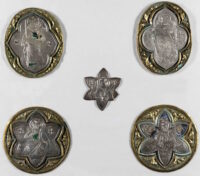
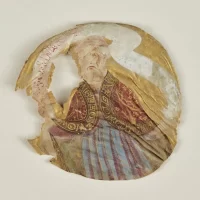
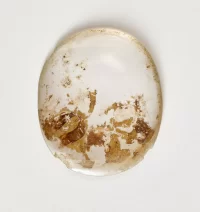
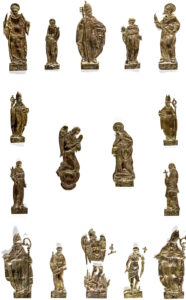
The Opificio delle Pietre Dure has again been tasked with the challenge of reintegrating the newly-rediscovered pieces. The Golden Tree will be dismantled in batches so that the main part of the reliquary can remain on display throughout the process. If all goes well, Opificio restorers hope the work will be completed by the end of next spring.
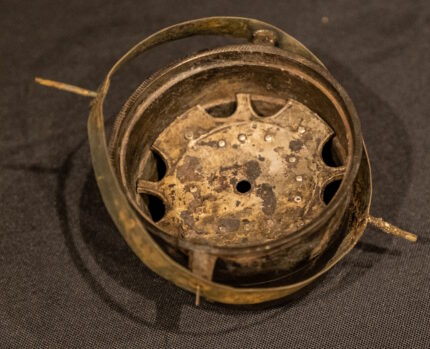 One of the artifacts recovered from the wreck of the medieval ship unearthed near the Old Town Harbor of Tallinn, Estonia, in 2022, is Europe’s oldest dry compass still in working order.
One of the artifacts recovered from the wreck of the medieval ship unearthed near the Old Town Harbor of Tallinn, Estonia, in 2022, is Europe’s oldest dry compass still in working order.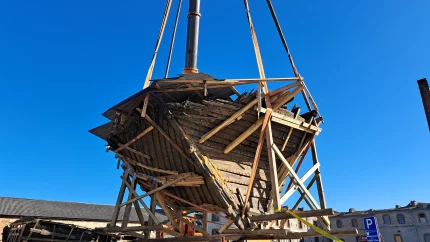 The cog was excavated from its location on Lootsi Street and transported to the Estonian Maritime Museum in four pieces. Archaeologists of the Estonian Maritime Museum and experts in ship conservation from Finland have been cleaning and conserving the cog in a purpose-built hall where visitors can see the work in progress.
The cog was excavated from its location on Lootsi Street and transported to the Estonian Maritime Museum in four pieces. Archaeologists of the Estonian Maritime Museum and experts in ship conservation from Finland have been cleaning and conserving the cog in a purpose-built hall where visitors can see the work in progress.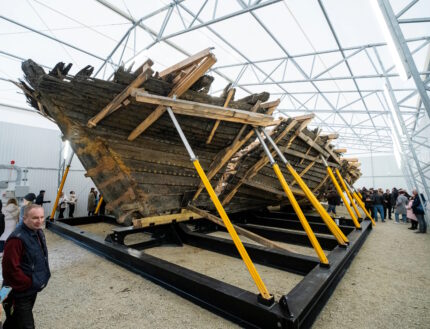 The excavation and conservation process uncovered a number of finds in excellent condition, including leather shoes, wooden spoons and tools, preserved by the waterlogged mud of the harbor. The shoes were well-worn and repaired, so not cargo intended for sale. This suggests the ship was sunk in an accident and everyone who could escape did so, leaving behind their belongings. The compass and the well-preserved remains of two rats who apparently did not desert the sinking ship were the most surprising finds.
The excavation and conservation process uncovered a number of finds in excellent condition, including leather shoes, wooden spoons and tools, preserved by the waterlogged mud of the harbor. The shoes were well-worn and repaired, so not cargo intended for sale. This suggests the ship was sunk in an accident and everyone who could escape did so, leaving behind their belongings. The compass and the well-preserved remains of two rats who apparently did not desert the sinking ship were the most surprising finds.[Archaeologist Priit Lätti of the Estonian Maritime Museum] aid that Estonia’s medieval ships really stand out among other similar finds because they are not empty. Medieval ships found in Germany and the Netherlands are mostly empty, the researcher said.
